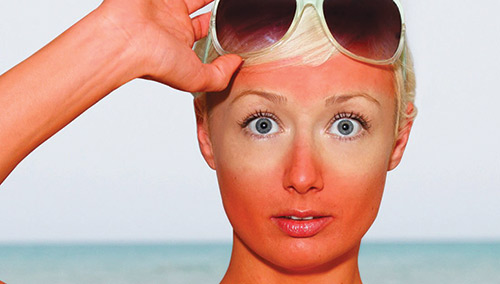 The Fourth of July weekend is just around the corner. Clean the pool, get out the lawn darts and fill up the cooler with your favorite adult beverage. It’s your time in the sun.
The Fourth of July weekend is just around the corner. Clean the pool, get out the lawn darts and fill up the cooler with your favorite adult beverage. It’s your time in the sun.
And if you’re not careful, you could get burned. If not by the charcoal grill, then by all that July 4 sunshine. It can take several hours for the full damage to show itself. So at the first sign, get out of the sun and follow this expert advice from The Skin Cancer Foundation.
Here’s a checklist for dealing with bad sunburn; but more importantly, you should not let it happen again. Your risk for melanoma doubles if you’ve had more than five sunburns.
- Act fast to cool it down
If you’re near a cold pool, lake or ocean, take a quick dip to cool your skin, but only for a few seconds so you don’t prolong your exposure. Then cover up and get out of the sun immediately. Continue to cool the burn with cold compresses. You can use ice to make ice water for a cold compress, but don’t apply ice directly to the sunburn. Or take a cool shower or bath, but not for too long, which can be drying, and avoid harsh soap, which might irritate the skin even more. - Moisturize while skin is damp
While skin is still damp, use a gentle moisturizing lotion (but not petroleum or oil-based ointments, which may trap the heat and make the burn worse). Repeat to keep burned or peeling skin moist over the next few days. - Decrease the inflammation
At the first sign of sunburn, taking a nonsteroidal anti-inflammatory drug (NSAID), such as ibuprofen, naproxen or aspirin, can help with discomfort and inflammation. You can continue with the NSAIDs as directed till the burn feels better. You can also use a one percent over-the-counter cortisone cream as directed for a few days to help calm redness and swelling. Aloe vera may also soothe mild burns and is generally considered safe. Wear loose, soft, breathable clothing to avoid further skin irritation, and stay out of the sun. - Replenish your fluids
Burns draw fluid to the skin’s surface and away from the rest of the body, so you may become dehydrated. It’s important to rehydrate by drinking extra liquids, including water and sports drinks that help to replenish electrolytes, immediately and while your skin heals. - See a doctor if…
You should seek medical help if you or a child has severe blistering over a large portion of the body, has a fever and chills, or is woozy or confused. Don’t scratch or pop blisters, which can lead to infection. Signs of infection include red streaks or oozing pus.
BOTTOM LINE
Your skin will heal, but real damage has been done. Repeat sunburns put you at a substantial risk for skin cancer and premature skin aging. Review the guidelines in The Skin Cancer Foundation’s Prevention Handbook at skincancer.org/prevention/graphics/handbook.
Reducing the risk of skin cancer
Protection from ultraviolet (UV) radiation is important all year round, not just during the summer or at the beach, says the Centers for Disease Control and Prevention. UV rays from the sun can reach you on cloudy and hazy days, as well as bright and sunny days. UV rays also reflect off of surfaces like water, cement, sand, and snow. Even indoor tanning beds expose users to UV radiation.
The hours between 10 a.m. and 4 p.m. Daylight Saving Time (9 a.m. to 3 p.m. standard time) are the most hazardous for UV exposure outdoors in the continental United States. UV rays from sunlight are the greatest during the late spring and early summer in North America.
CDC recommends easy options for protection from UV radiation:
- Stay in the shade, especially during midday hours.
- Wear clothing that covers your arms and legs.
- Wear a hat with a wide brim to shade your face, head, ears, and neck.
- Wear sunglasses that wrap around and block both UVA and UVB rays.
- Use sunscreen with sun protection factor (SPF) 15 or higher, and both UVA and UVB protection. SPF refers to the length of time that sunscreen protects the skin. Suppose your skin naturally starts to burn in 20 minutes. If you use sunscreen with an SPF of 15, you won’t begin to burn for five hours — 15 times longer.
Choosing a sunscreen
- SPF. Sunscreens are assigned a sun protection factor number that rates their effectiveness in blocking UV rays. Higher numbers indicate more protection. You should use a broad spectrum sunscreen with at least SPF 15. Choose a product that contains zinc oxide, titanium dioxide, or avobenzone, also known as Parsol 1789.
- Reapplication. Sunscreen wears off. Put it on again if you stay out in the sun for more than two hours and after swimming, sweating, or toweling off.
- Expiration date. Check the sunscreen’s expiration date. Sunscreen without an expiration date has a shelf life of no more than three years, but its shelf life is shorter if it has been exposed to high temperatures.
- Cosmetics. Some makeup and lip balms contain some of the same chemicals used in sunscreens. If they do not have at least SPF 15, don’t use them by themselves.
 Learn from the burn. Remember how bad this sunburn felt, then commit to protecting yourself from the sun every day, all year long.
Learn from the burn. Remember how bad this sunburn felt, then commit to protecting yourself from the sun every day, all year long.
Learn more about protecting your skin in The Skin Cancer Foundation’s Prevention Handbook at www.skincancer.org/prevention/graphics/handbook.

